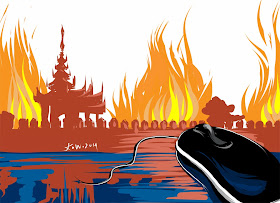 |
| Mouse clicks and Mandalay, illustration by Kenneth Wong |
The headline read, "Two Muslim Brothers, Owners of [XX] Teashop, Raped a Buddhist Woman Worker." The story ran, "Thit Htoo Lwin learned that, on the evening of July 28, at the [XX] teashop located at the corner of [XX] and [XX] streets, owners U [XX] and his younger brother Ko [XX] (Muslims) deceived their cook Ma [XX] (Buddhist) and raped her."
 |
| Thit Htoo Lwin's news story as it appeared on Facebook. |
The original item published in Burmese identified the teashop by name and precise location. It also provided full names of the accused and the victim. I have decided to exclude them in my translation here because I feel it's the responsible thing to do when writing about unconfirmed incidents involving real people.
Perhaps that's what I found most troubling about this story. In reporting the crime, where neither guilt nor innocence has been proven in the court of law, Thit Htoo Lwin's reporter spelled out the names of all parties involved, with a complete disregard for their personal safety and privacy. The reporter -- who, by the way, chose to remain anonymous -- inserted in parentheses the faiths of the perpetrators and the victim, dressing up the crime as a religiously motivated one.
In the same week, Thit Htoo Lwin also published the story of a student who was drugged with sex stimulants and violated; and the story of a drunken, schizophrenic man who strangled his wife. Neither mentioned the religions of the parties involved.
 |
| Wirathu picked up the story on his Facebook page. |
Nevertheless, the site has more than 5,500 followers. And when it publishes something, a good many of its Facebook fans tend to share it on their own profiles. Even if they find the story too outrageous to believe, they still share it in order to comment on it or to initiate a discussion thread. That seemingly benign practice, unfortunately, contributes to the buildup of toxic content online. At last count, Thit Htoo Lwin's tea shop rape case has received 1,800+ recommendations or "likes" on Facebook.
The story really caught fire when controversial monk Wirathu picked it up on his Facebook page and added a few choice words of his own. (He called the accused "Muslim Mafia brothers.") The story has logged 885 "shares" across Wirathu's network so far, and who knows how many more secondary distribution it has received from thereon.
By the morning of July 1, as I brew my coffee here in California, I discovered something dark and bitter was also brewing across the Pacific in Mandalay. Now my Burmese friends' Facebook feeds talked of a mob, gathering by the site of the teashop identified in the story. Some talked of unruly groups attacking storefronts identified as Muslim-owned businesses. Others talked of riot police arriving on the scene. (Photos of the riot from BBC Burmese and The Irrawaddy.)
At midnight on July 1, according to The Irrawaddy, U Karwira, known as Galunni Abbot, and a group of Buddhist monks arrived. They did their best to dissuade the rioters and asked them to disperse, but met with resistance. (The Irrawaddy's photo shows the moment the monks confronted the rioters.) The crowd finally scattered, leaving behind smashed vehicles.
Thit Htoo Lwin has since deleted the original story, but digital remnants of it still exist. Other blogs and websites copied and republished the story in its entirety.
Today, as the Burmese Muslims observed the first week of Ramadan and the Buddhists got ready for the full moon of Waso, Mandalay woke up to a calm but tense sunrise, with police patrolling the troubled spots. Fourteen people were injured in the riots, and two died, according to 7 Day Daily. One of the casualties was a young man out riding a bike with his friend. Another was a bicycle shop owner. The former was a Buddhist, the latter a Muslim.
Ko Shine Win, the Malaysia Relief Agency's country coordinator for Burma, was a friend of the Muslim man who was killed. Soon after learning of his friend's death, Shine Win changed his Facebook cover image to read "Pray for Myanmar: Peace and Harmony."
In today's tinderbox environment of Burma, it only takes one irresponsible news story and a few thousand mouse clicks on Facebook to set Mandalay or any other major city ablaze. I'm praying my countrymen learn to distinguish a legitimate news story from one that's calculated to fuel sectarian conflicts, and use their mouse clicks to put a stop to the latter.
Note: The post was revised to reflect the casualty count and injuries reported by 7 Day Daily.
Update: Wirathu has deleted his Facebook post where he referred to the news story about the alleged rape that appeared in This Htoo Lwin's website; however, a version of the post still remains on Wirathu's blog here.
No comments:
Post a Comment